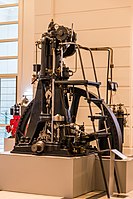
Photo from wikipedia
Abstract In order to reduce the engine size and mass of spacecraft for Mars missions, powdered magnesium (Mg) and carbon dioxide rocket engines should use liquid carbon dioxide (liquid CO2)… Click to show full abstract
Abstract In order to reduce the engine size and mass of spacecraft for Mars missions, powdered magnesium (Mg) and carbon dioxide rocket engines should use liquid carbon dioxide (liquid CO2) as their oxidizer. Experimental studies are carried out on the characteristics of liquid CO2 feed, powdered Mg feed, engine ignition, combustion, and pressure oscillation. Results show that both the feeding systems of liquid CO2 and powdered Mg work stably. Although the use of liquid CO2 makes ignition more difficult, reliable ignition and a stable flame are achieved by means of multi-step ignition. The Damkohler number, L/[vj × (ti + tb)], incorporates the parameters of pre-combustion chamber length, powder-injection velocity, particle ignition delay, and burning time. Successful ignition is indicated by Damkohler number>1. Fluctuations in the powdered Mg feeding flowrate will cause serious combustion chamber pressure oscillation, whose maximum relative amplitude can be suppressed from 5.3% to 1.8% by choosing a suitable fluidization gas. Serious depositions are generated in the pre-chamber, which influence the propellant injection process and stable combustion process. The maximum relative amplitude of combustion pressure oscillation caused by this problem can grow up to 6%. The combustion efficiency of the engine reaches 83%, validating the feasibility of the powdered Mg and liquid CO2 rocket engine.
Journal Title: Acta Astronautica
Year Published: 2021
Link to full text (if available)
Share on Social Media: Sign Up to like & get
recommendations!